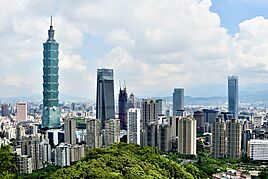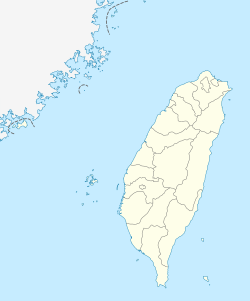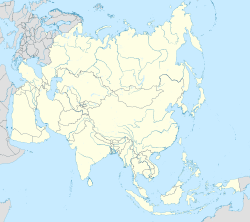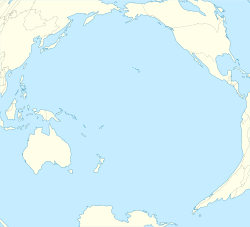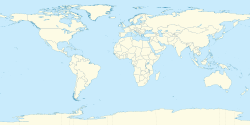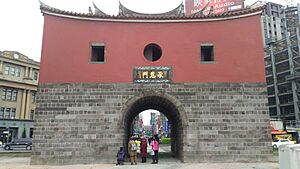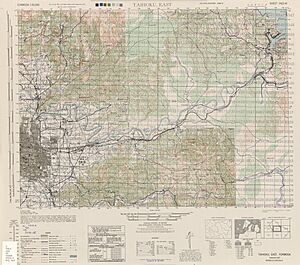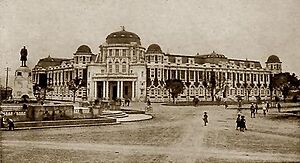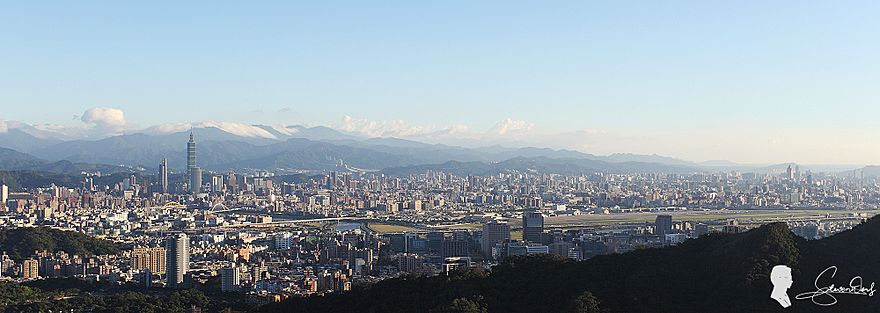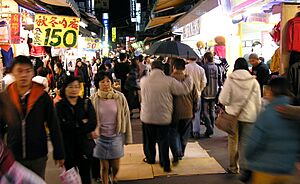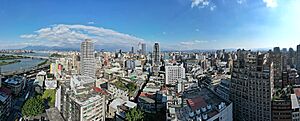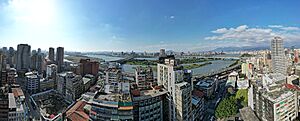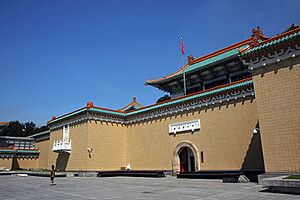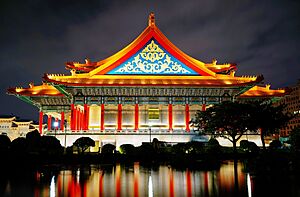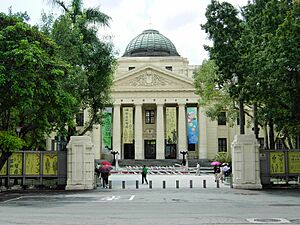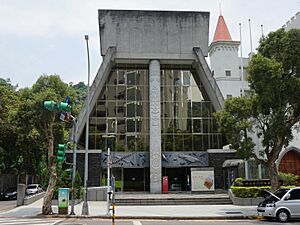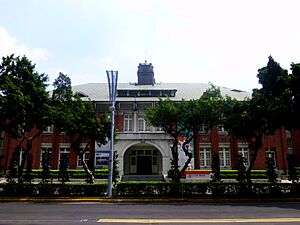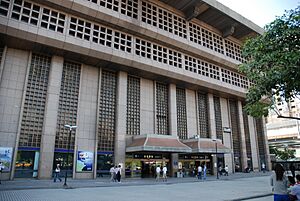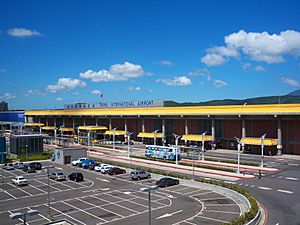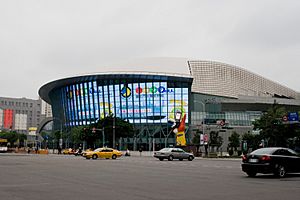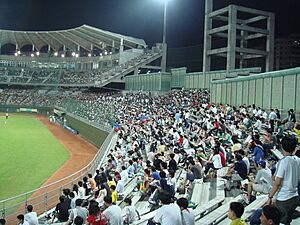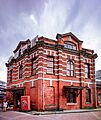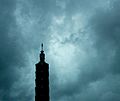Taipei facts for kids
Quick facts for kids
Taipei City
臺北市
Tai-pak, Taipeh
|
|||
|---|---|---|---|
|
Skyline of Taipei from Elephant Mountain with Taipei 101 (left)
Ximending
Presidential Office
Qixing Mountain
Bangka Lungshan Temple
|
|||
|
|||
| Etymology: Wade–Giles: Tʻai²-pei³; literally "North of Taiwan" | |||
| Nickname(s):
The City of Azaleas
|
|||
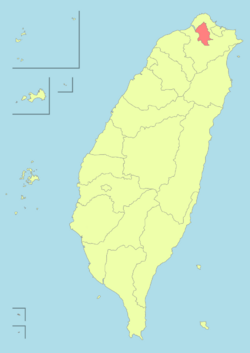 |
|||
| Country | |||
| Settled | 1709 | ||
| Renamed Taihoku | 17 April 1895 | ||
| Provincial city status | 25 October 1945 | ||
| Provisional national capital | 7 December 1949 | ||
| Reconstituted as a Yuan-controlled municipality | 1 July 1967 | ||
| City seat | Xinyi District 25°02′15″N 121°33′45″E / 25.03750°N 121.56250°E |
||
| Districts | 12 | ||
| Largest district | Daan District | ||
| Government | |||
|
• Mayor
|
Chiang Wan-an (KMT) | ||
| Legislature | Taipei City Council | ||
| National representation | |||
| 8 of 113 constituencies | |||
| Area | |||
|
• Total
|
271.80 km2 (104.94 sq mi) (16th) | ||
|
• Water
|
2.7 km2 (1.0 sq mi) | ||
| Population | |||
|
• March 2023 estimate
|
2,494,813 (4th)
9,078,000 (urban) (4th) |
||
| GDP (PPP) | 2016 estimate | ||
|
• Total
|
$65,539 (1st) | ||
| GDP (nominal) | 2016 estimate | ||
|
• Total
|
NT$990,292 (1st) | ||
| Time zone | UTC+8 (National Standard Time) | ||
| Calling code | (0)2 | ||
| Postal code |
100–116
|
||
| ISO 3166 code | TW-TPE | ||
| Website | |||
| Symbols | |||
| Bird | Formosan blue magpie (Urocissa caerulea) | ||
| Flower | Azalea (Rhododendron nudiflorum) | ||
| Tree | Banyan (India laurel fig, Ficus microcarpa) | ||
| Taipei City | |||||||||||||||||||||||||||||||||||||||||||||||
|---|---|---|---|---|---|---|---|---|---|---|---|---|---|---|---|---|---|---|---|---|---|---|---|---|---|---|---|---|---|---|---|---|---|---|---|---|---|---|---|---|---|---|---|---|---|---|---|

"Taipei" in Traditional (top) and Simplified (bottom) Chinese characters
|
|||||||||||||||||||||||||||||||||||||||||||||||
| Traditional Chinese | 臺北市 | ||||||||||||||||||||||||||||||||||||||||||||||
| Simplified Chinese | 台北市 | ||||||||||||||||||||||||||||||||||||||||||||||
| Literal meaning | "North of Tai[wan]" | ||||||||||||||||||||||||||||||||||||||||||||||
|
|||||||||||||||||||||||||||||||||||||||||||||||
Taipei is the capital city of Taiwan. It is a special municipality located in Northern Taiwan. Taipei City is surrounded by New Taipei City. It sits about 25 kilometers (15 miles) southwest of the port city of Keelung. Most of Taipei is in the Taipei Basin, which used to be an ancient lakebed. Rivers like the Keelung River and Xindian River flow into the Tamsui River along the city's western edge.
Taipei is home to about 2.5 million people (as of March 2023). It is the main part of the Taipei–Keelung metropolitan area, also called "Greater Taipei." This larger area includes New Taipei and Keelung, with a total population of over 7 million. This makes it one of the most populated urban areas in the world. About one-third of all people in Taiwan live in this metro area.
Taipei has been the political center of Taiwan since 1887. It served as the capital of Taiwan Province under different governments. Since 1949, it has been the national seat of the Republic of China (ROC) government. On July 1, 1967, Taipei became a special municipality.
Taipei is the main center for Taiwan's economy, politics, education, and culture. It is a major hub for high-tech industries. The city has excellent connections, including railways, highways, airports, and bus lines. Two airports serve the city: Songshan and Taoyuan.
The city is famous for its buildings and cultural sites. These include Taipei 101 (once the world's tallest building), Chiang Kai-shek Memorial Hall, Bangka Lungshan Temple, National Palace Museum, and the Presidential Office Building. Popular shopping areas like Ximending and many night markets are also found here. Natural spots like Maokong and Yangmingshan offer beautiful views and hot springs.
Sometimes, in English news, "Taipei" refers to the entire government of Taiwan. Because of Taiwan's unique international situation, the term "Chinese Taipei" is often used. This happens when Taiwan's representatives join international groups or when athletes compete in events like the Olympics.
Contents
Understanding Taipei's Names
The name Taipei comes from the way it was written in the past, Tʻai²-pei³. This means "North of Taiwan" in Chinese. Today, you might also see it written as Táiběi.
The city has also been called Tai-pak (from a local Taiwanese language) and Taipeh.
During the time Japan ruled Taiwan (1895 to 1945), Taipei was known as Taihoku. This was the Japanese way of saying the Chinese characters for Taipei.
Taipei's Rich History
Before many Chinese settlers arrived, the Taipei Basin was home to native people called Ketagalan. More Chinese people started moving here in the early 1700s. This happened when the Qing Dynasty government allowed more development in the area.
In 1875, the northern part of Taiwan became a new administrative area called Taipeh Prefecture. Taipei was made the temporary capital of the island in 1887. It officially became the provincial capital in 1894.
When Japan took control of Taiwan in 1895, they called the city Taihoku. The Japanese rulers made big plans for the city. They built many railroads and important buildings. Many famous Taipei landmarks today come from this time.
After Japan lost World War II in 1945, the Republic of China (ROC) took control of Taiwan. In December 1949, the ROC government moved to Taiwan after a war on mainland China. They declared Taipei the temporary capital of the ROC.
In 1990, Taipei was the site of the Wild Lily student movement. These student protests helped Taiwan become a multi-party democracy by 1996. Since then, Taipei has been the seat of Taiwan's democratically elected government.
Early Settlers and Qing Dynasty Rule
The Taipei Basin was originally inhabited by Ketagalan tribes. Chinese settlers from different parts of Fujian province began to arrive in 1709.
In the late 1800s, the Taipei area became important for trade, especially for tea. In 1875, northern Taiwan became the new Taipeh Prefecture. The new capital, called Chengnei ("the inner city"), was built next to busy towns. Taipei was the capital of this prefecture until 1895.
In 1885, Taipei was chosen as the temporary capital for the whole island. It officially became the capital in 1894. Today, only the north gate remains from the old city walls. Other gates were changed or removed over time.
Japanese Rule and Modern Changes
When Japan took over Taiwan in 1895, Taipei was renamed Taihoku. It became the main political center for the Japanese government. Many public buildings and homes for government workers were built during this time. The Presidential Office Building is one example.
In 1920, Taihoku became part of Taihoku Prefecture. It grew to include nearby areas like Bangka and Twatutia. In 1938, Matsuyama (now Songshan District, Taipei) was added. During World War II, Taihoku was bombed by Allied forces. The biggest attack was on May 31, 1945.
Taipei After World War II
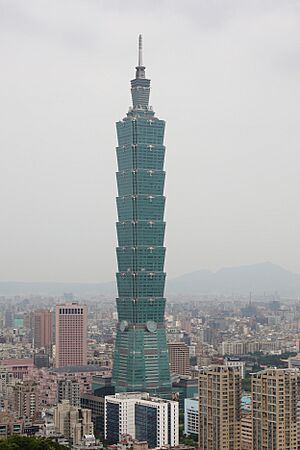
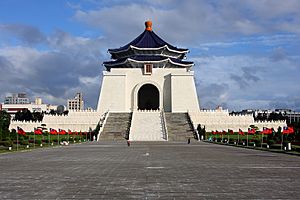
After Japan's defeat in 1945, the Kuomintang (KMT) government of the Republic of China took control of Taiwan. Taipei became a provincial city. In 1947, the KMT government declared martial law in Taiwan after an incident that started in Taipei.
On December 7, 1949, the KMT government moved to Taiwan after losing a war in mainland China. They declared Taipei the temporary capital of the Republic of China.
Taipei grew a lot after 1949. On July 1, 1967, it became a special municipality. The next year, Taipei City expanded even more. It added areas like Shilin, Beitou, and Neihu. This made the city four times bigger and increased its population to 1.56 million.
The city's population kept growing, reaching over 2 million by the mid-1970s. Even though growth inside the city slowed down later, Taipei remained a very crowded urban area. The population continued to grow in areas around the city.
In 1990, Taipei's 16 districts were combined into the current 12 districts. Large protests in Liberty Square that year helped Taiwan become a full democracy.
Taipei's Geography and Climate

Taipei City is in the Taipei Basin in northern Taiwan. The Xindian River borders it to the south, and the Tamsui River to the west. The central areas are mostly flat, but the land rises to the south, east, and especially to the north. In the north, you'll find Qixing Mountain, which is 1,120 meters (3,675 feet) tall. It's a dormant volcano in Yangmingshan National Park. The northern districts of Shilin and Beitou are north of the Keelung River and next to Yangmingshan National Park. Taipei City covers about 271.8 square kilometers (104.9 square miles).
Two peaks, Qixing Mountain and Mt. Datun, are northeast of the city. Qixing Mountain is the tallest mountain around the Taipei Basin. Mt. Datun is 1,092 meters (3,583 feet) high. These old volcanoes are part of Yangmingshan National Park.
To the southeast, there are the Songshan Hills and the Qingshui Ravine. These areas have lush green woods.
Taipei's Weather
Taipei has a humid subtropical climate. This means summers are long, very hot, and humid. They often have heavy rainstorms and typhoons. Winters are short, generally warm, and very foggy. This fog comes from cool winds from Siberia that get trapped in the Taipei Basin.
In winter, daytime temperatures can often go above 26°C (79°F). In summer, they can drop below that during afternoon showers. Cold fronts in winter can lower the temperature by 3 to 5°C (5 to 9°F). However, temperatures rarely drop below 10°C (50°F). Snow has never been recorded in the city itself, only on mountains within the city limits like Yangmingshan.
Taipei is affected by the Pacific typhoon season, which runs from June to October.
Air Quality in Taipei
Taipei is good at managing its air quality compared to other Asian cities. Its rainy weather, coastal location, and strong environmental rules help prevent major air pollution problems. However, smog is common, and visibility can be poor after days without rain.
Exhaust from vehicles, especially motor scooters, is a source of air pollution. Levels of tiny particles and harmful chemicals are higher in the mornings. This is because there is less air movement then. Sunlight helps reduce some pollution later in the day.
Taipei's Cityscape
Taipei's People
Taipei City has about 2.5 million people (as of 2022). The larger Taipei–Keelung metropolitan area has over 7 million people. While Taipei City's population has gone down a bit recently, the population of nearby New Taipei has grown. The city has tried to encourage more births, which has helped slow the population decrease.
Taipei's population is not spread out evenly. Districts like Daan, Songshan, and Datong are the most crowded. These areas, along with nearby towns, have some of the most densely populated neighborhoods in the world.
In 2008, the birth rate was 7.88%, and the death rate was 5.94%. An important issue for the city is its decreasing and aging population. By the end of 2009, one in ten people in Taipei was over 65 years old. Over 43% of the population had a college education or higher. The literacy rate was very high, at 99.18%.
Like the rest of Taiwan, Taipei has four main ethnic groups: Hoklos, Waishengren, Hakkas, and aborigines. Hoklos and Waishengren make up most of the city's population. Many Hakkas have moved to the city in recent years. The aboriginal population in the city was about 16,713 in 2018, mostly in the outer districts. In 2022, there were 71,858 foreigners living in Taipei, mainly from Indonesia, the Philippines, and Japan.
Taipei's Economy
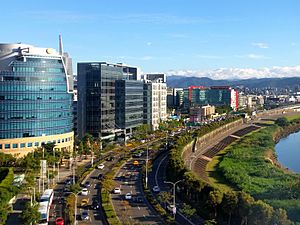
Taipei is Taiwan's main business, finance, and technology center. It has been key to the country's fast economic growth. This growth is part of the "Taiwan Economic Miracle." It happened after a lot of foreign money was invested in the 1960s. Taiwan is now a "creditor economy," meaning it lends money to other countries. It has one of the world's largest foreign money reserves.
Even with the Asian financial crisis, Taipei's economy keeps growing by about 5% each year. Almost everyone has a job, and prices are stable. The city's economy was worth $327 billion in 2014. In 2013, Taipei's average income per person was the 5th highest in East Asia. It was behind Tokyo, Singapore, Osaka, and Hong Kong, but ahead of Seoul, London, and Paris.
The Financial Times ranked Taipei very high for its economic potential (2nd) and how easy it is to do business (4th) in 2015. Taipei is home to 30 billionaires, making it 16th in the world, ahead of cities like Los Angeles and Sydney. Business Insider also ranked Taipei as the 5th most high-tech city globally in 2017.
Taipei focuses on technology, electronics, biotechnology, and financial services. Most of Taiwan's big companies are based here. These include Acer Computers, Asus, and CTBC Bank. Five Global Fortune 500 companies have their headquarters in Taipei.
Many international companies and banks also have offices in Taipei. This means Taipei has almost 3,500 foreign businesses. It attracts over half of all foreign investment in Taiwan. Companies like Google, Microsoft, IBM, and Apple have offices here. Most financial firms are in the Xinyi Special District. Tech companies are often in the Neihu Technology Park or Nankang Software Park.
Taipei's startup scene is also very active. In 2018, Microsoft invested $34 million to create an AI research center here. Google plans to hire 300 people and train 5,000 more in AI. IBM is also expanding its research center in Taipei. Taipei's entrepreneurial spirit ranked 6th worldwide and 1st in Asia in 2016. The city has over 400 startups.
Tourism is a smaller but important part of the economy. In 2008, almost 3 million international visitors came to Taipei. In 2013, visitors spent $10.8 billion in the city. This was the 9th highest in the world and the most in any Chinese-speaking city.
Taipei's Culture and Fun
Top Tourist Attractions
Tourism is a big part of Taipei's economy. In 2013, over 6.3 million people from other countries visited Taipei. This made it the 15th most visited city globally. These visitors brought $10.8 billion to the city's economy in 2013. This was the 9th highest in the world.
Famous Memorials and Museums
The National Chiang Kai-shek Memorial Hall is a monument and tourist spot. It honors General Chiang Kai-shek, a former leader of the Republic of China. It stands at the east end of Memorial Hall Square. Here you'll also find the National Concert Hall and National Theater. These landmarks are close to Taiwan's Presidential Office Building.
The National Taiwan Museum is nearby in 228 Peace Memorial Park. It is Taiwan's oldest museum, started in 1908 by the Japanese government. It opened with 10,000 items to celebrate the new North-South Railway.
The National Palace Museum is a huge art gallery and museum. It has a permanent collection of ancient Chinese artifacts. This museum is not the same as the Palace Museum in Beijing. Both museums share a common history. The National Palace Museum in Taipei has one of the world's largest collections of ancient Chinese art.
The Shung Ye Museum of Formosan Aborigines is very close to the National Palace Museum. It shows art and historical items made by Taiwanese aborigines. It also has many multimedia displays.
The Taipei Fine Arts Museum opened in 1983. It was the first museum in Taiwan just for modern art. Most of the art is by Taiwanese artists from 1940 onwards.
The National Sun Yat-sen Memorial Hall is near Taipei 101. It honors Sun Yat-sen, a founder of the Republic of China. This hall, finished in 1972, now serves as a multi-purpose center for social, educational, and cultural events.
In 2001, the Museum of Contemporary Art Taipei opened. It is in a building that used to be Taipei City government offices.
Taipei 101 Skyscraper
Taipei 101 is a 101-floor landmark skyscraper. It was the world's tallest building when it opened in 2004. It held this title for six years until the Burj Khalifa in Dubai was finished. Taipei 101 is 509 meters (1,670 feet) tall. It was the first skyscraper to be over half a kilometer high.
It was built to withstand typhoon winds and earthquakes. Its design has many smart engineering ideas. It has won many international awards. Today, Taipei 101 is still one of the tallest skyscrapers. It is also certified as the world's largest "green" building. Its shopping mall and observatories attract visitors from all over the world. The New Year's Eve fireworks show at Taipei 101 is famous worldwide.
Performing Arts Venues
The National Theater and Concert Hall are in Taipei's Liberty Square. They host shows by both local and international performers. Other major concert places include Zhongshan Hall and the Sun Yat-sen Memorial Hall.
A new place, the Taipei Performing Arts Center, opened in 2022. It is near the Shilin Night Market. This center has three theaters for longer shows.
Shopping and Fun Activities
Taipei is known for its many night markets. The Shilin Night Market in the Shilin District is very popular. The streets around it are very busy in the evening. Most night markets have stalls selling food, clothes, and other goods.
Ximending has been a shopping and entertainment area since the 1930s. It has old buildings like a concert hall and a historic cinema. Modern buildings house karaoke places, movie theaters, and stores. This walking area is very popular with teenagers. It is sometimes called the "Harajuku" of Taipei.
The new Xinyi District is popular with both tourists and locals. It has many entertainment and shopping spots. It is also home to Taipei 101. Malls here include Shin Kong Mitsukoshi, Breeze Center, and Taipei 101 mall. The Xinyi district is also the center of Taipei's busy nightlife, with many bars and nightclubs.
The shopping area around Taipei Main Station includes the Taipei Underground Market. Other popular shopping spots are the Zhongshan Metro Mall and the Guang Hua Digital Plaza. The Miramar Entertainment Park is famous for its large Ferris wheel and IMAX theater.
Taipei has many parks, green spaces, and nature areas. Important parks include Yangmingshan National Park, Taipei Zoo, and Da-an Forest Park. Yangmingshan National Park is 10 kilometers (6 miles) north of the city center. People visit it for its cherry blossoms, hot springs, and sulfur deposits. The Taipei Zoo was started in 1914. It covers 165 hectares (408 acres) for animal habitats.
Bitan is a good place for boating and water sports. Tamsui is a popular seaside town. You can also reach ocean beaches from Taipei.
Taipei's Temples
Taipei has many temples dedicated to gods from Chinese folk religion, Taoism, and Chinese Buddhism. The Bangka Lungshan Temple, built in 1738, is in the Wanhua District. It shows old Chinese architectural styles. Qingshui Temple and Qingshan Temple are also famous temples in Wanhua District.
Other temples include Baoan Temple in historic Dalongdong. It is a national historical site. The Xia Hai City God Temple is in the old Dadaocheng community. The Taipei Confucius Temple dates back to 1879.
Ciyou Temple in Songshan District, Guandu Temple in Beitou District, Hsing Tian Kong in Zhongshan District, and Zhinan Temple in Wenshan District are also popular. Xinsheng South Road is known for having many temples, churches, and other places of worship.
The Shandao Temple, built in 1929, is the largest Buddhist temple in Taipei. Fo Guang Shan has a modern temple in Xinyi District. Dharma Drum Mountain has an education center and a monastery. The Linji Huguo Chan Temple is one of the few well-preserved Japanese-style Buddhist temples in Taiwan.
Besides large temples, small outdoor shrines are very common. You can find them next to roads, in parks, and in neighborhoods. Many homes and businesses also have small shrines with candles and offerings.
Taipei's Festivals and Events
Many yearly festivals happen in Taipei. Some festivals, like the Double Ten Day fireworks, are now held in different cities across Taiwan each year.
On New Year's Eve (solar calendar), thousands gather in Taipei's Xinyi District. They enjoy parades, outdoor concerts, and street shows. The highlight is the countdown to midnight, when Taipei 101 becomes a giant fireworks platform.
The Taipei Lantern Festival ends the Lunar New Year holiday. The city's lantern display happens at the same time as the national festival in Pingxi. There, thousands of fire lanterns are released into the sky. Taipei's lantern display moves to different downtown locations each year.
On Double Ten Day, patriotic celebrations take place in front of the Presidential Office Building. Other annual festivals include Ancestors Day, the Dragon Boat Festival, and the Mid-Autumn Festival. The Qing Shan King Sacrificial Ceremony is a grand, century-old festival held every year in Wanhua District.
Taipei often hosts international events. It hosted the 2009 Summer Deaflympics. Then came the Taipei International Flora Exposition, a garden festival from November 2010 to April 2011. This was the first of its kind in Taiwan.
Getting Around Taipei
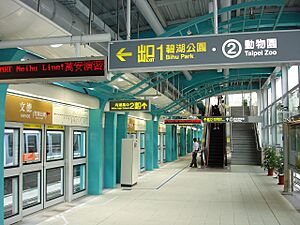
Public transport is very popular in Taipei. In 2022, 34.9% of trips were made using public transit. This is higher than any other place in Taiwan. Private transport includes motor scooters, cars, taxis, and bicycles. Private transport made up 41.6% of trips in 2022, the lowest in Taiwan.
Taipei Main Station is a big hub for the subway, buses, regular trains, and high-speed rail. You can use a contactless smartcard called EasyCard for all public transit. You can also use it at some stores. The EasyCard is read by special panels on buses and in MRT stations.
Taipei's Metro System
Taipei's public transport system, the Taipei Metro (MRT), has a metro and light rail system. It uses advanced technology. There are currently six metro lines. They are organized by color, line number, and station name. The Taipei Metro also includes other public facilities. These include the Maokong Gondola, underground shopping malls, and parks. Old railway lines are being updated to join the metro system.
In 2017, a rapid transit line opened to connect Taipei with Taiwan Taoyuan International Airport. This new line is part of the Taoyuan Metro system.
On January 31, 2020, the first part of the Circular line officially opened. This is a 15.4 km (9.6 miles) driverless rail system. It offered free rides in February 2020 for people to try it out.
Train Travel in Taipei
Starting in 1983, train lines in the city were moved underground. This was part of the Taipei Railway Underground Project. The Taiwan High Speed Rail system opened in 2007. These bullet trains connect Taipei with cities on the west coast. They cut travel times by 60% or more compared to buses or regular trains. The Taiwan Railways Administration also runs passenger and freight services across the island.
Bus System
A large city bus system serves areas not covered by the metro. It has special bus lanes to help with traffic. If you use the metro, you can use your EasyCard for cheaper bus fares, and vice versa. A special thing about Taipei's bus system is that private companies run the routes together. They share the same fare system. This is different from bus systems in many other countries. Several big intercity bus stations are in the city. These include the Taipei Bus Station and Taipei City Hall Bus Station.
Airports Serving Taipei
Most international flights use Taoyuan International Airport. This airport is in nearby Taoyuan City. Songshan Airport is in the heart of Taipei, in the Songshan District. It handles domestic flights and flights to Tokyo, Seoul, and about 15 cities in China. You can reach Songshan Airport by the Taipei Metro Neihu Line. Taoyuan International Airport is reached by the Taoyuan Airport MRT.
Ticketing System
In 1994, Taipei planned to create a better transport system for its growing city. In 1999, a company called Thales was chosen to help. Thales was chosen again in 2005 to upgrade Taipei's public transport network. They set up a system where you can pay without touching anything. This system works for 116 metro stations, 5,000 buses, and 92 car parks.
Learning in Taipei
Taipei is home to 24 universities and Academia Sinica. Academia Sinica is Taiwan's national academy. It supports the Taiwan International Graduate Program.
- Academia Sinica (started 1928)
- National Taiwan University (started 1928)
- National Chengchi University (started 1927)
- National Defense Medical Center (started 1902)
- National Defense University (started 1906)
- National Taipei University of Technology (started 1912)
- National Taipei University (started 1949)
- National Taipei University of Business (started 1917)
- National Taipei University of Education (started 1895)
- National Taipei University of Nursing and Health Science (started 1947)
- National Taiwan University of Science and Technology (started 1974)
- National Taiwan College of Performing Arts (started 1957)
- National Taiwan Normal University (started 1922)
- National Yang Ming Chiao Tung University (started 1975)
- Taipei National University of the Arts (started 1982)
- University of Taipei (started 2013)
- Tamkang University (started 1950)
- Soochow University (started 1900)
- Chinese Culture University (started 1962)
- Ming Chuan University (started 1957)
- Shih Hsin University (started 1956)
- Shih Chien University (started 1958)
- Taipei Medical University (started 1960)
- Tatung University (started 1956)
- China University of Technology (started 1965)
National Taiwan University (NTU) was founded in 1928 during Japanese rule. Many of Taiwan's political and social leaders have studied at NTU. The university has six campuses in the greater Taipei area. It also has farms, forests, and hospitals for teaching and research. Its main campus is in Taipei's Da-An district. The National Taiwan University Hospital is a top center for medical research.
National Taiwan Normal University (NTNU) also started during Japanese rule. It was founded in 1922. NTNU has grown into a full international university. It is known for its humanities and international education programs. It is also famous for its Mandarin Training Center. This program teaches Mandarin to over a thousand students from many countries each year. The main campus is in Taipei's Daan district.
Sports in Taipei
The Wei Chuan Dragons are a professional baseball team in Taiwan's Chinese Professional Baseball League. They are based in Taipei. Taipei also has two professional basketball teams: the Taipei Taishin Mars and the Taipei Fubon Braves.
Major Sporting Events Hosted by Taipei
Here are some recent sports events Taipei has hosted:
- 2004 FIFA Futsal World Championship
- 2006 Women's Baseball World Cup
- 2007 Baseball World Cup
- 2009 Summer Deaflympics
- 2013 Badminton Asia Championships
- 2017 Summer Universiade
- 2022 U-23 Baseball World Cup (co-hosted)
- 2023 U-18 Baseball World Cup (co-hosted)
- 2024 World Junior Figure Skating Championships
- 2025 Summer World Masters Games (co-host with New Taipei City)
- Taipei Marathon (annual): This marathon is one of Taiwan's two top road races.
The Taipei Arena is on the site of the old Taipei Municipal Baseball Stadium. It can hold over 15,000 people. It opened in 2005. It hosts more concerts and cultural events than sports events, even though it was built for sports. The Chinese Taipei Ice Hockey League plays in the auxiliary arena.
Taipei Dome and Tianmu Baseball Stadium are the main baseball venues. The Taipei Dome will have 40,071 seats and is expected to be finished by the end of 2023.
Taipei Municipal Stadium is a multi-purpose stadium. It hosts football and track and field events, as well as concerts. It was rebuilt in 2009.
Youth Baseball Success
In 2010, a Taipei baseball team, Chung-Ching Junior Little League, won the Junior League World Series. They won after beating teams from the Asia-Pacific, Mexico, and Latin America regions. Then they defeated the U.S. champion. Taiwan's Little League World Series international team has won 17 championships, which is the most wins in the league.
Media in Taipei

As the capital, Taipei City is home to many television and radio stations in Taiwan. It is also where some of the country's largest newspapers are based.
Television Stations
Television stations in Taipei include:
- CTS Education and Culture
- China Television
- Chinese Television System
- Chung T'ien Television
- Eastern Television
- Era Television
- Formosa TV
- Gala Television
- Public Television Service
- Sanlih E-Television
- Taiwan Broadcasting System
- Videoland Television Network
- Taiwan Television
- TVBS
Newspapers
Newspapers include:
- Apple Daily
- The China Post
- China Times
- Liberty Times
- Mandarin Daily News
- Taipei Times
- Taiwan News
- United Daily News
Taipei's International Connections
Taipei was part of the Asian Network of Major Cities 21 before it ended.
Sister Cities and Twin Towns
Taipei has sister city relationships with many cities around the world. These partnerships help build friendships and cultural exchange.
United States
 Houston, TX, United States (1961)
Houston, TX, United States (1961) San Francisco, CA, United States (1970)
San Francisco, CA, United States (1970) Guam, United States (1973)
Guam, United States (1973) Cleveland, OH, United States (1975)
Cleveland, OH, United States (1975) Indianapolis, IN, United States (1978)
Indianapolis, IN, United States (1978) Marshall, TX, United States (1978)
Marshall, TX, United States (1978) Atlanta, GA, United States (1979)
Atlanta, GA, United States (1979) Los Angeles, CA, United States (1979)
Los Angeles, CA, United States (1979) Phoenix, AZ, United States (1979)
Phoenix, AZ, United States (1979) Oklahoma City, OK, United States (1981)
Oklahoma City, OK, United States (1981) Boston, MA, United States (1996)
Boston, MA, United States (1996) Dallas, TX, United States (1996)
Dallas, TX, United States (1996)
Outside United States
 Lomé, Togo (1966)
Lomé, Togo (1966) Manila, Philippines (1966)
Manila, Philippines (1966) Cotonou, Benin (1967)
Cotonou, Benin (1967) Quezon City, Philippines (1968)
Quezon City, Philippines (1968) Seoul, South Korea (1968)
Seoul, South Korea (1968) Santo Domingo, Dominican Republic (1970)
Santo Domingo, Dominican Republic (1970) Jeddah, Saudi Arabia (1978)
Jeddah, Saudi Arabia (1978) Gold Coast, Queensland, Australia (1982)
Gold Coast, Queensland, Australia (1982) Johannesburg, South Africa (1982)
Johannesburg, South Africa (1982) Pretoria, South Africa (1983)
Pretoria, South Africa (1983) Lilongwe, Malawi (1984)
Lilongwe, Malawi (1984) San José, Costa Rica (1984)
San José, Costa Rica (1984) Versailles, France (1986)
Versailles, France (1986) Asunción, Paraguay (1987)
Asunción, Paraguay (1987) Panama City, Panama (1989)
Panama City, Panama (1989) Managua, Nicaragua (1992)
Managua, Nicaragua (1992) San Salvador, El Salvador (1993)
San Salvador, El Salvador (1993) Warsaw, Masovian Voivodeship, Poland (1995)
Warsaw, Masovian Voivodeship, Poland (1995) Ulan-Ude, Buryatia, Russia (1996)
Ulan-Ude, Buryatia, Russia (1996) Dakar, Senegal (1997)
Dakar, Senegal (1997) Banjul, Gambia (1997)
Banjul, Gambia (1997) Bissau, Guinea-Bissau (1997)
Bissau, Guinea-Bissau (1997) Mbabane, Eswatini (1997)
Mbabane, Eswatini (1997) Ulaanbaatar, Mongolia (1997)
Ulaanbaatar, Mongolia (1997) San Nicolás, Nuevo León, Mexico (1997)
San Nicolás, Nuevo León, Mexico (1997) La Paz, Bolivia (1997)
La Paz, Bolivia (1997) Guatemala City, Guatemala (1998)
Guatemala City, Guatemala (1998) Monrovia, Liberia (1998)
Monrovia, Liberia (1998) Vilnius, Lithuania (1998)
Vilnius, Lithuania (1998) Majuro, Marshall Islands (1999)
Majuro, Marshall Islands (1999) Riga, Latvia (2001)
Riga, Latvia (2001) Ouagadougou, Burkina Faso (2008)
Ouagadougou, Burkina Faso (2008) Daegu, South Korea (2010)
Daegu, South Korea (2010) Quito, Ecuador (2015/2016)
Quito, Ecuador (2015/2016) Castries, St. Lucia (2015/2016)
Castries, St. Lucia (2015/2016) Belmopan, Belize (2019)
Belmopan, Belize (2019) Prague, Czech Republic (2020)
Prague, Czech Republic (2020) Lima, Peru (2020)
Lima, Peru (2020) Apia, Samoa
Apia, Samoa
Partner Cities
 Anchorage, AK, United States (1997)
Anchorage, AK, United States (1997) Yokohama, Kanagawa, Japan (2006)
Yokohama, Kanagawa, Japan (2006) Wellington, New Zealand (2015)
Wellington, New Zealand (2015)
Friendship Cities
 Perth, Western Australia, Australia (1999)
Perth, Western Australia, Australia (1999) Gyeonggi-do, South Korea (2000)
Gyeonggi-do, South Korea (2000) Orange County, CA, United States (2000)
Orange County, CA, United States (2000) George Town, Penang, Malaysia (2009)
George Town, Penang, Malaysia (2009) Helsinki, Finland (2012)
Helsinki, Finland (2012)
Images for kids
-
New Year fireworks at Taipei 101
-
Taipei Story House (Yuanshan Mansion)
 |
 |
|||
See also
 In Spanish: Taipéi para niños
In Spanish: Taipéi para niños


